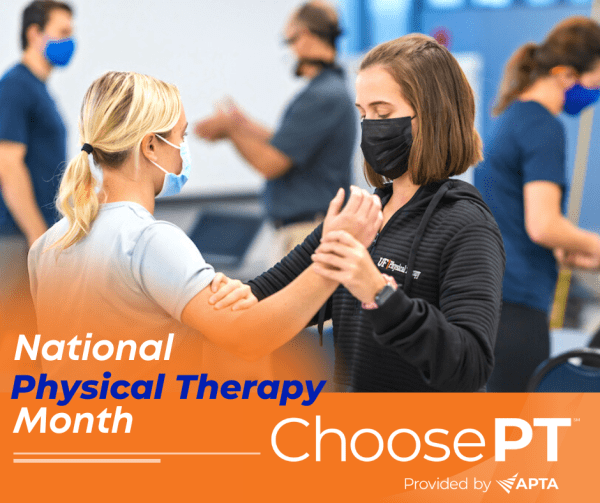October is National Physical Therapy Month
October is National Physical Therapy Month, an opportunity to raise awareness of the benefits of physical therapy. This year is the 30th year the American Physical Therapy Association (APTA) and participating components have celebrated Physical Therapy Month (NPTW).
The theme this year is “Choose to Move,” which emphasizes physical therapists’ unique value as movement experts and the benefits of regular physical activity. Physical therapists are licensed health care providers. They evaluate, diagnose, and manage health conditions and movement problems in people of all ages and abilities. They empower people to take an active role in their care.
Physical therapists also play a unique role in promoting health, wellness, and fitness. They help people overcome barriers to regular physical activity to benefit physical, mental, and social health. Physical therapists are movement experts who team with physical therapist assistants to treat people of all ages and abilities. The more you move, the better your health. They can help you avoid surgery and prescription drugs, maximize your mobility, manage pain and chronic conditions, and improve your physical function and fitness.
The American Physical Therapy Association offers the following tips to help you reduce your risk of falling:
- Get moving. For older adults, physical activity reduces the risk of falling and fall-related injuries. Stay active to maintain the strength, flexibility, coordination, and balance needed to prevent falls. From swimming to yoga to walking, take part in a variety of physical activities that you enjoy. Talk to your physical therapist to determine which activities are safe for you.
- Know your risks. A physical therapist can help you assess your risk factors and develop a plan to address them so you can remain independent. Tell your doctor or physical therapist if you have any dizziness, loss of balance, or trouble seeing. Be sure to tell them whether you fell in the last year.
- Check your medications. Many drugs can cause dizziness, loss of balance, blurry vision, and more. If you have any of these symptoms, review your medications with your pharmacist or doctor.
- Assess your home’s safety. Assess your home to fix or remove anything that could cause trips or slips, such as throw rugs, clutter, poor lighting, and wobbly furniture or handrails. It’s also a good idea to install a secure grab bar in the shower and next to the toilet for sturdy support on slippery floors. If you can’t make these safety improvements yourself, ask a friend or family member to help. Check with your doctor, physical therapist, or area agency on aging for local programs that offer home safety assessments.
- Work with a physical therapist. Physical therapy (with exercise) focused on balance, stability, and the ability to perform common tasks is recommended and can prevent falls, according to the U.S. Preventive Services Task Force. Physical therapists are able to help you avoid a fall in the first place, as they are movement experts who can work with you to assess your fall risk factors and develop a plan to address them. They will advise you on making your home safer, educate you about medical risk factors linked to falls, and design a safe balance training program specific to you.
To learn more about the hands-on care, patient education, and prescribed movement that a physical therapist can provide, visit ChoosePT.com, where you can contact a physical therapist directly for an evaluation.
With the right resources and support, you can reduce your risk of a fall and maintain your quality of life.

